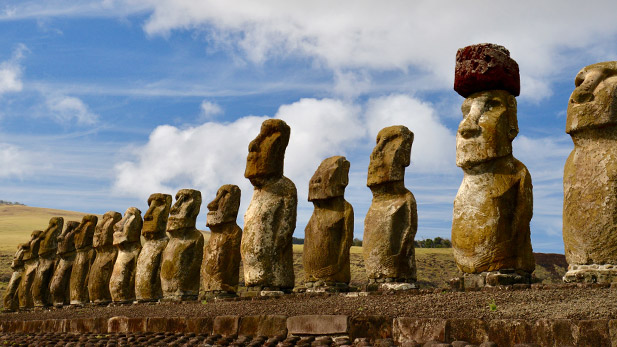World-Renowned Anthropologist to Discuss Future of Rapa Nui’s Statues at First Guerri Lecture

Internationally renowned anthropologist, archaeologist and educator Terry Hunt will share his research about the Rapa Nui’s (Easter Island) history and culture as the first event in the Elmer and Deanna Guerri Lecture in Anthropology Series.
Internationally renowned anthropologist, archaeologist and educator Terry Hunt will share his research about the Rapa Nui’s (Easter Island) history and culture in a public lecture Wednesday, Oct. 30, from 4-5:30 p.m. in the Hatfield Hall theater at Rose-Hulman Institute of Technology.
Hunt’s speech will cover the topic “Transporting Easter Island’s Massive Statues (Moai): New Research Resolves an Enduring Mystery.”
Free and open to the public, this is the first event in the Elmer and Deanna Guerri Lecture in Anthropology Series at Rose-Hulman. The lecture has been organized by the anthropology program in the institute’s Department of Humanities, Social Sciences and the Arts. No advanced tickets are required for this event and seating in the theater is on a first-come, first-served basis.
Hunt, dean of the University of Arizona’s Honors College, is one of the world’s foremost experts on the human and environmental histories of the Pacific Islands. He has conducted field research for more than four decades. His book “The Statues That Walked: Unraveling the Mystery of Easter Island,” co-authored with Carl Lipo, details Rapa Nui’s ancient history.
Located in the middle of the Pacific Ocean, 2,000 miles from the mainland in Chile, Rapa Nui is home to some of the most remarkable statues to be found anywhere in the world. It is the most remote of all the islands to be settled in the first millennium AD by the Polynesians.
“This is a great opportunity for anthropologists, archaeologists, geographers, historians and people to learn about the world, and how other civilizations developed and eventually collapsed. Also, there are many lessons to be learned by this experience,” says Paul Christensen, assistant professor of anthropology at Rose-Hulman.
Elmer Guerri, a Terre Haute resident and 1965 Rose-Hulman chemistry alumnus, is an archaeology and anthropology enthusiast. He has supported the institute’s anthropology program, and regularly presents guest lectures about indigenous peoples and yet-living cultures within New Guinea, Easter Island, South America, Africa and the Americas. Elmer and his wife, Deanna, also have provided nine scholarships to Rose-Hulman students earning a minor in anthropology.
“The Guerri Anthropology Lecture Series showcases that Rose-Hulman has a thriving anthropology program that’s educating students to preserve the future by appreciating our past,” says Elmer Guerri.
Christensen says approximately three to four students earn a minor in anthropology annually, while Introduction to Anthropology is a popular elective course for students in all academic science, engineering and mathematics majors.
One of Elmer Guerri’s favorite Rose-Hulman activities was working with art professor Soully Abas to provide lectures about the cave art of Spain and France. He then helped bring a cave-like structure on campus, allowing students to create their own cave art wall paintings, etchings and sculptures – replicating conditions of Paleolithic Europe.
Guerri also has escorted Rose-Hulman students to visit the Cahokia Mounds site near St. Louis, along with hosting students and their families to tour his museum-style displays of artifacts and cultural material from around the world.
Editor-in-chief of the Prehistoric American journal, Guerri has contributed several features to archaeology and anthropology publications. He serves as curator of the Olive Branch Site Assemblage for the American Society of Amateur Archaeology. Guerri has served on several national anthropology advisory boards, and is on the planning committee with colleagues from Texas A&M University’s Center for the Study of First Americans on the 2021 ODYSSEY First Americans Conference in Santa Fe, New Mexico.